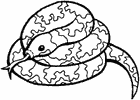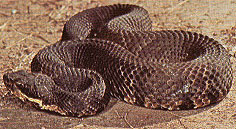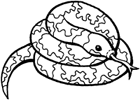| Right-side or Left-side: Do Snakes Have a Preference for Coiling Direction? |  |
| Right-side or Left-side: Do Snakes Have a Preference for Coiling Direction? |  |
|
November 5, 2003 Approximately 90% of all people are right-handed: meaning they prefer to use their right hand for tasks such as writing and throwing a ball. Some other mammals and birds also show a preference for the side they use. Snakes do not have limbs, so it is impossible to test their "handedness," but Dr. Eric Roth (Department of Zoology, University of Oklahoma) has tested these reptiles for the direction they prefer to coil. Dr. Roth studied the coiling behavior of 30 cottonmouth snakes over a six-month period. He made 1813 observations of the direction each snake coiled. |
Western Cottonmouth Copyright: Missouri Department of Conservation |
|
Clockwise Coil |
Counterclockwise Coil |
Adult snakes (16 of 20 snakes) preferred to coil in the
clockwise
direction. Many female snakes (15 of 20 snakes), but few male snakes (only
4 of 10 snakes), also tended to coil in a clockwise pattern.
Dr. Roth suggests that the location of internal organs such as the lungs, kidney and stomach may affect coiling direction. For example, in some snakes, the right lung is pushed aside by the stomach and the left lung is smaller than the right lung. These anatomical features may influence coiling direction so that the snake can maximize behaviors such as striking or regulating body temperature. Coiling direction may also be influenced by differences in the anatomy of the right and left sides of the snake brain. Just as humans have a right or left brain dominance for many behaviors, snakes may also have brain asymmetries to control what they do. |
|
References:
|
| GO TO: | Neuroscience In The News | Explore the Nervous System | Table of Contents |
![[email]](./gif/menue.gif) Send E-mail |
 Fill out survey |
 Get Newsletter |
 Search Pages |